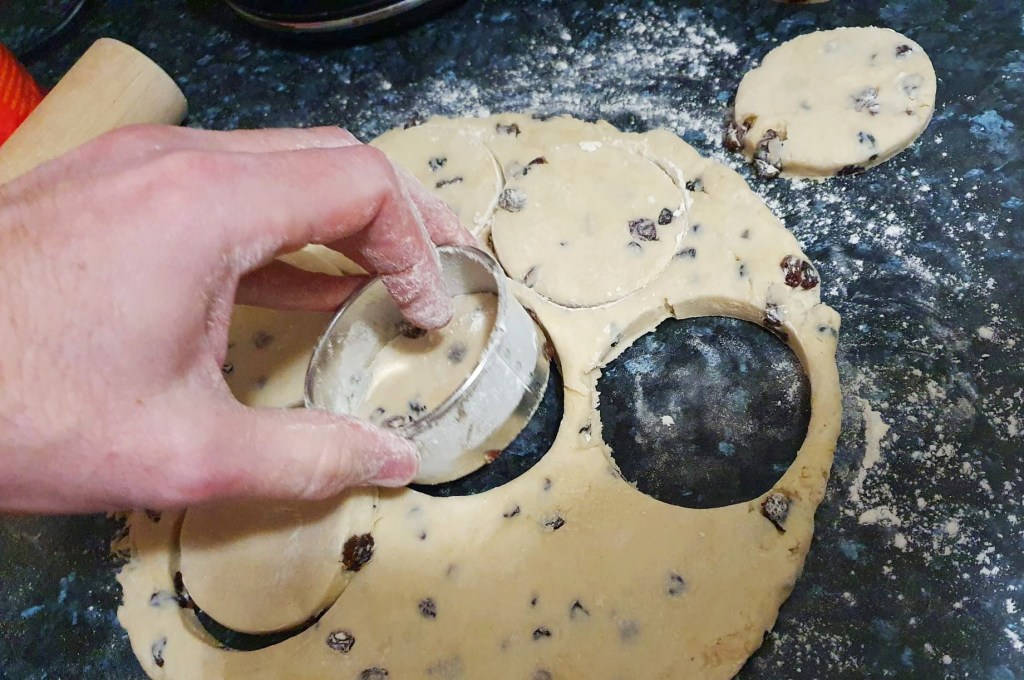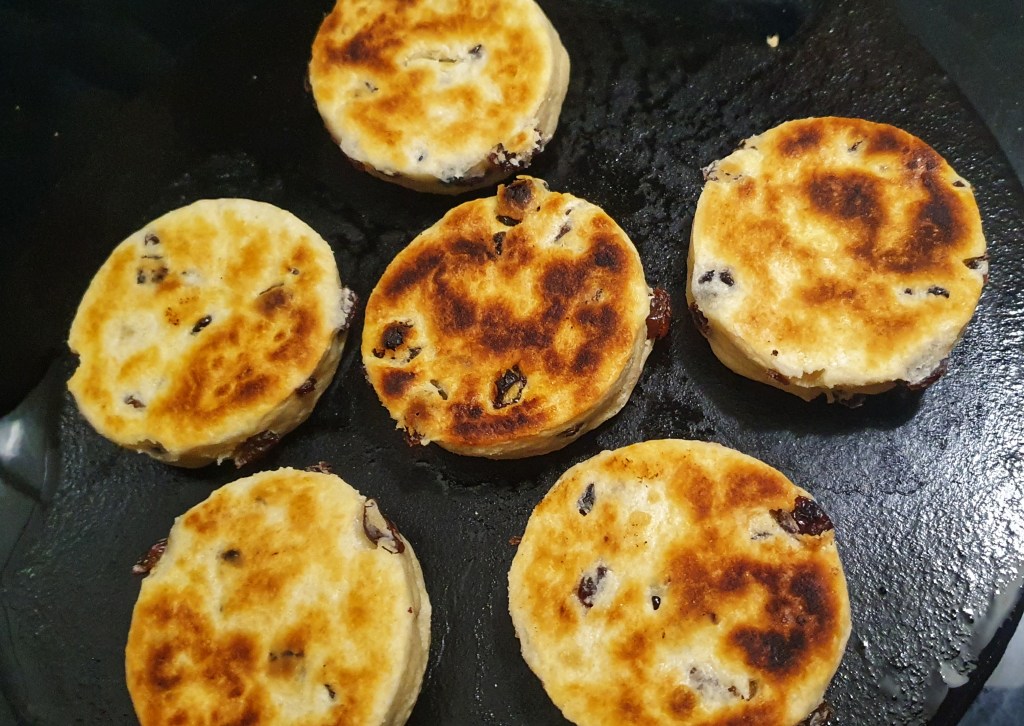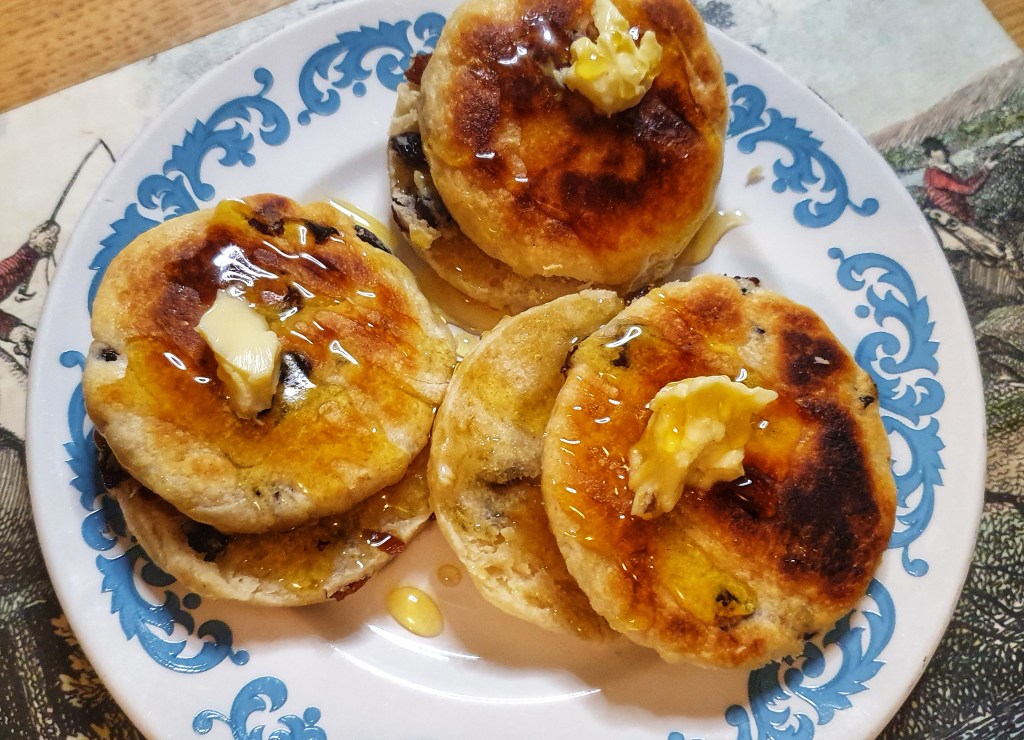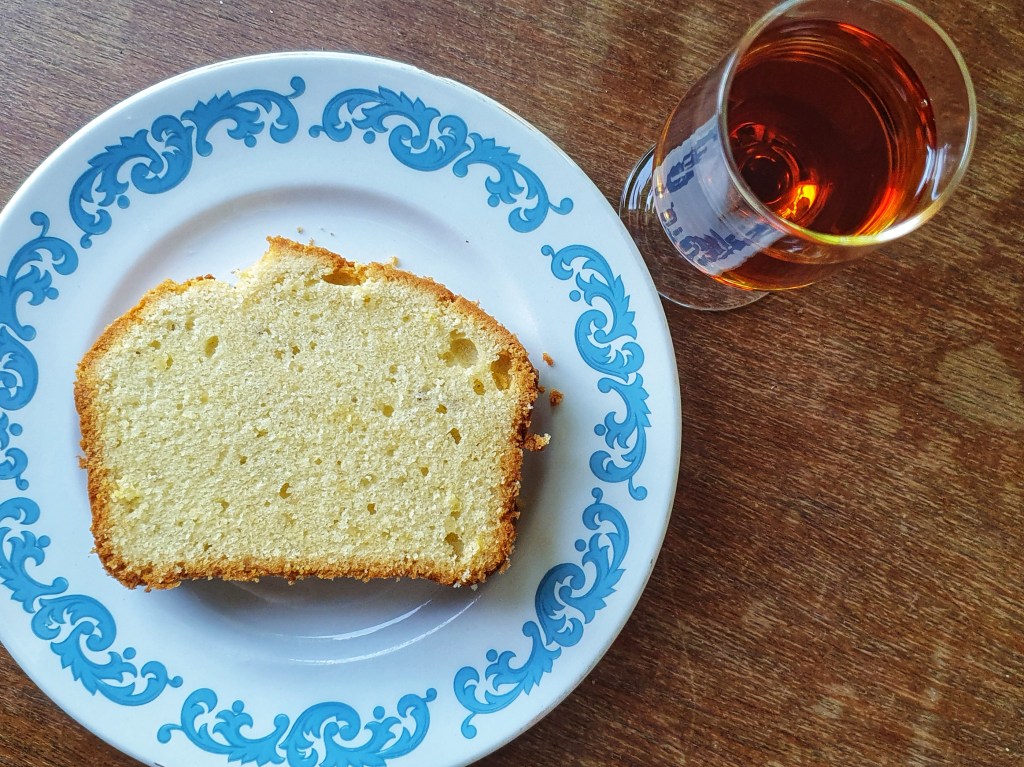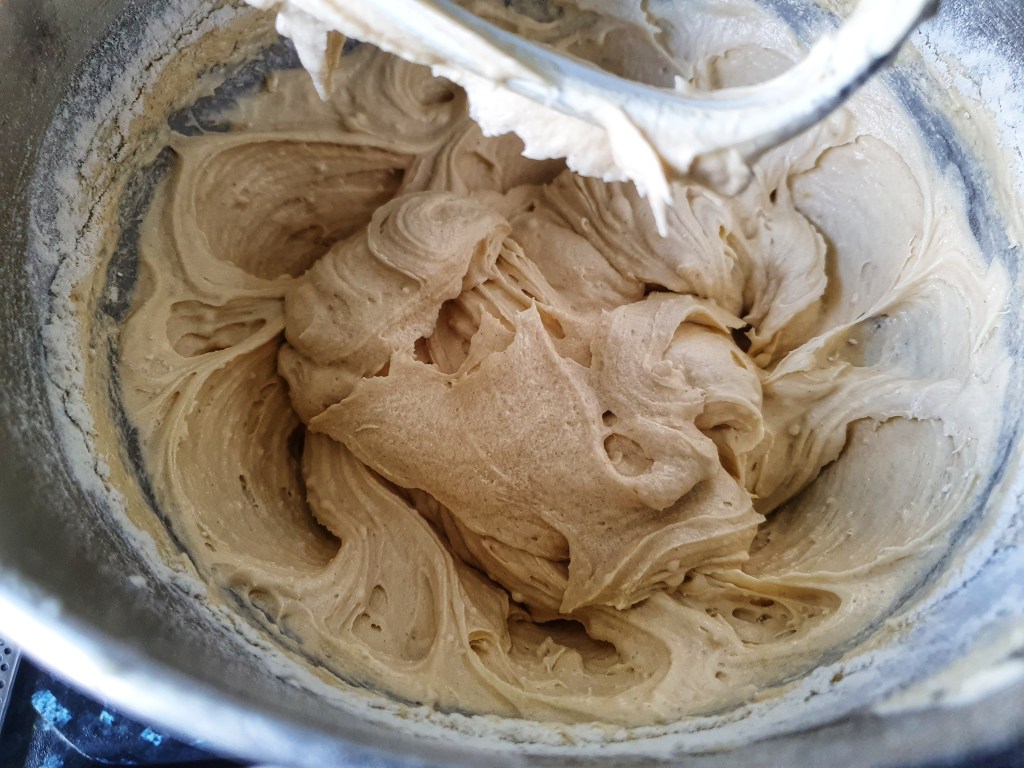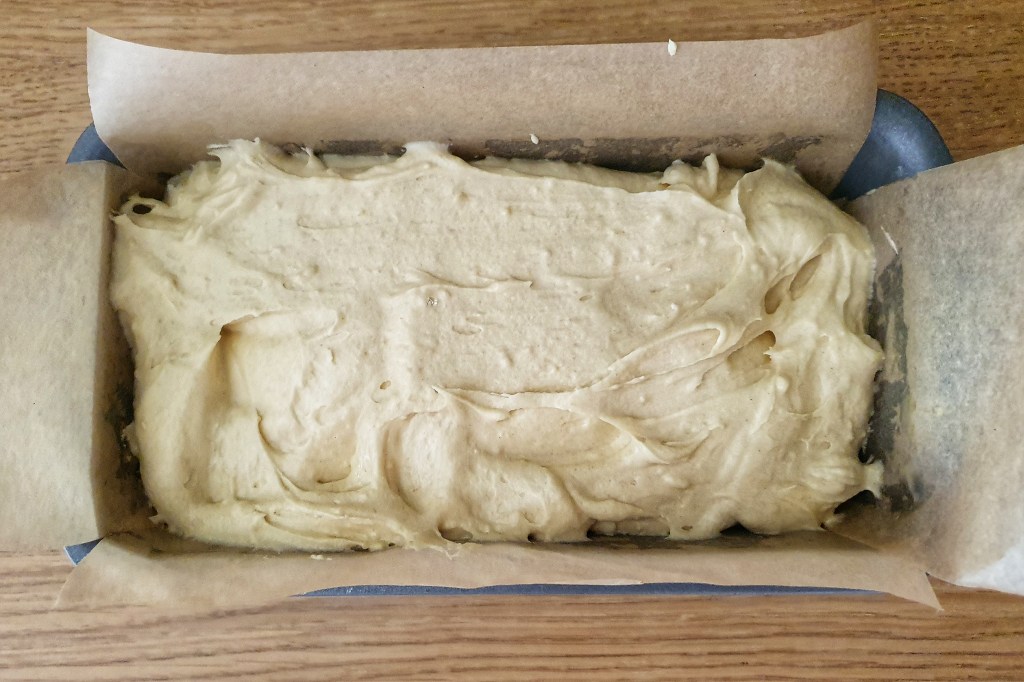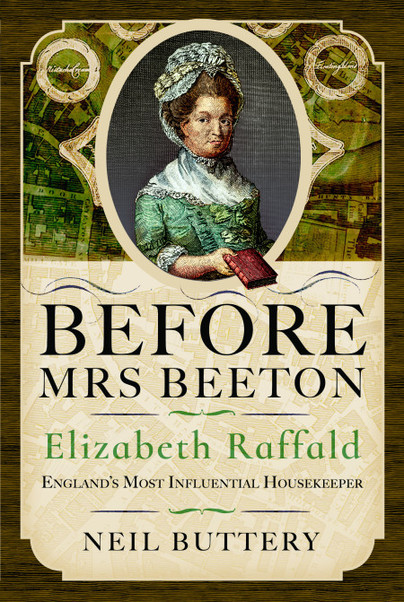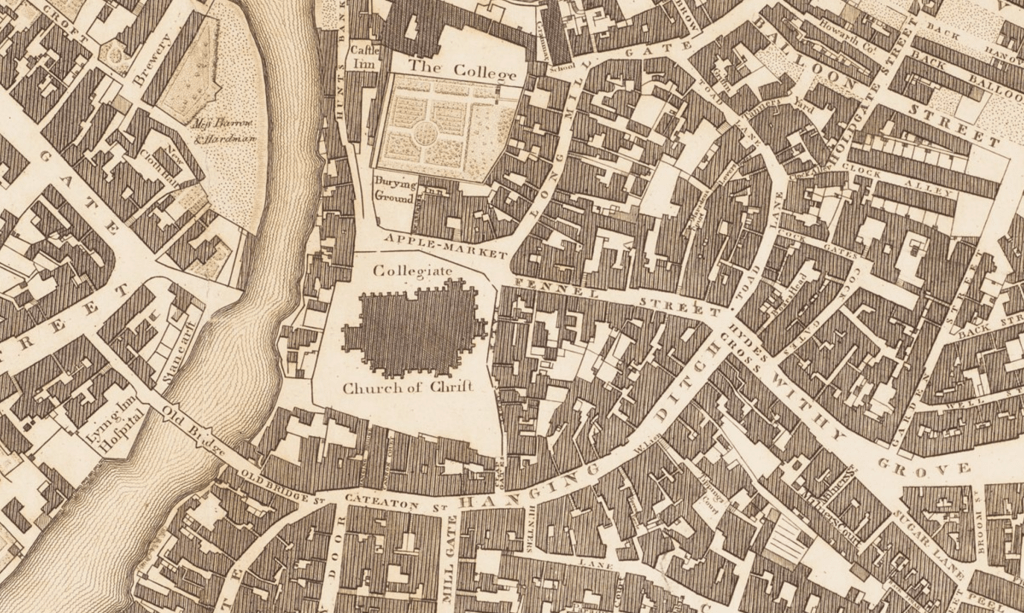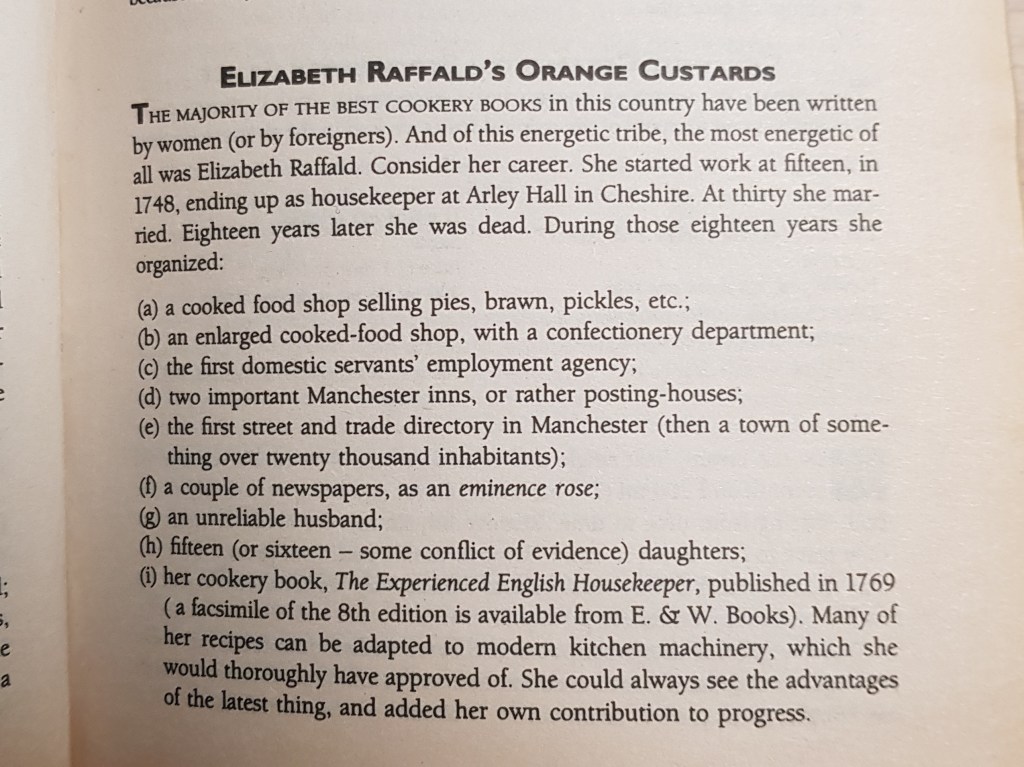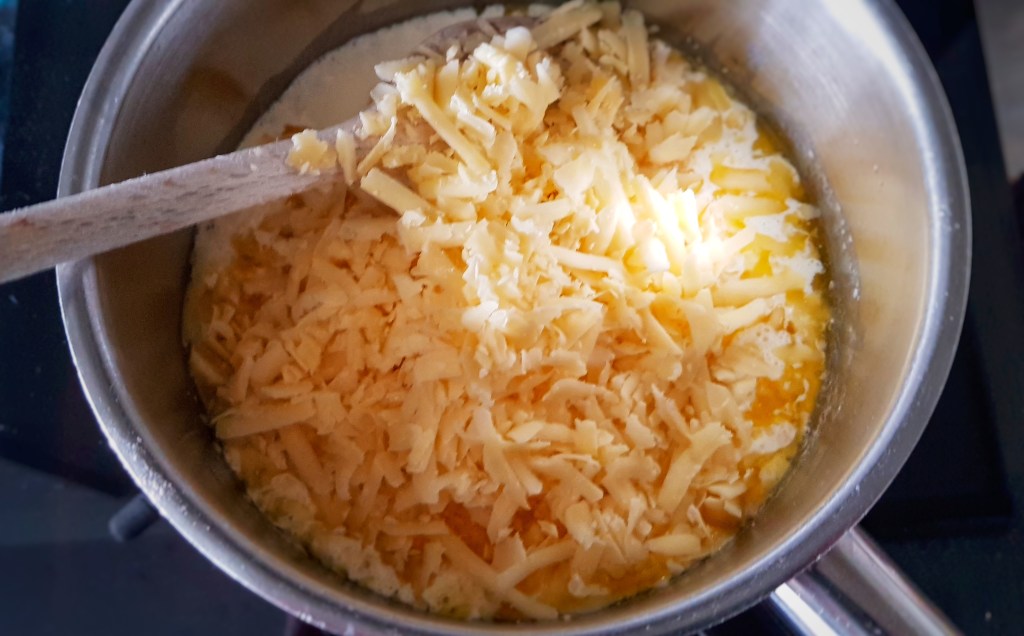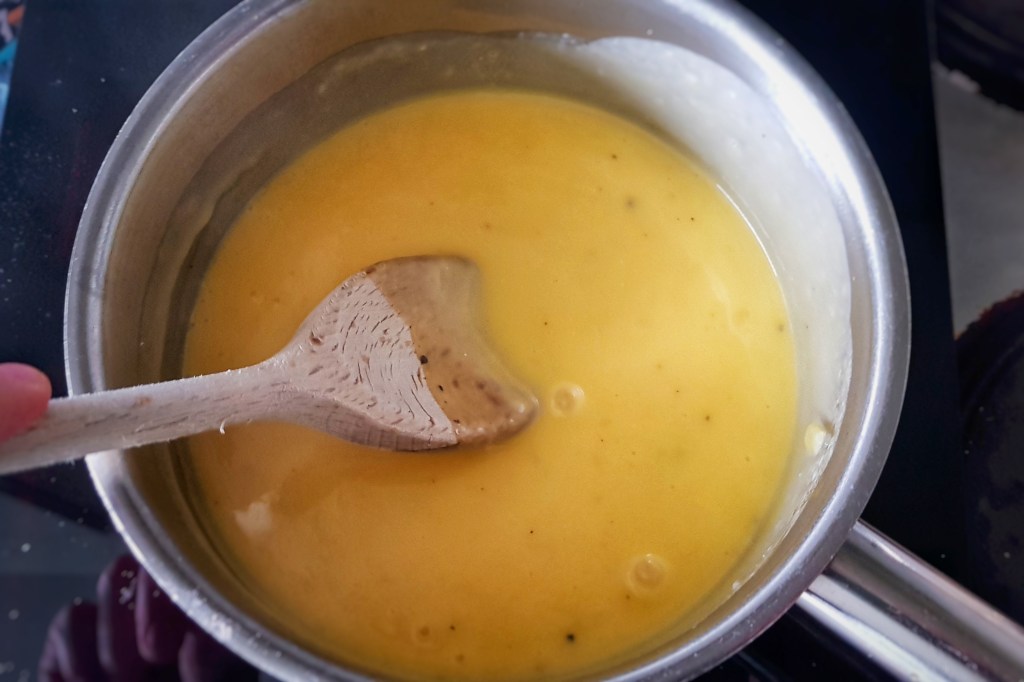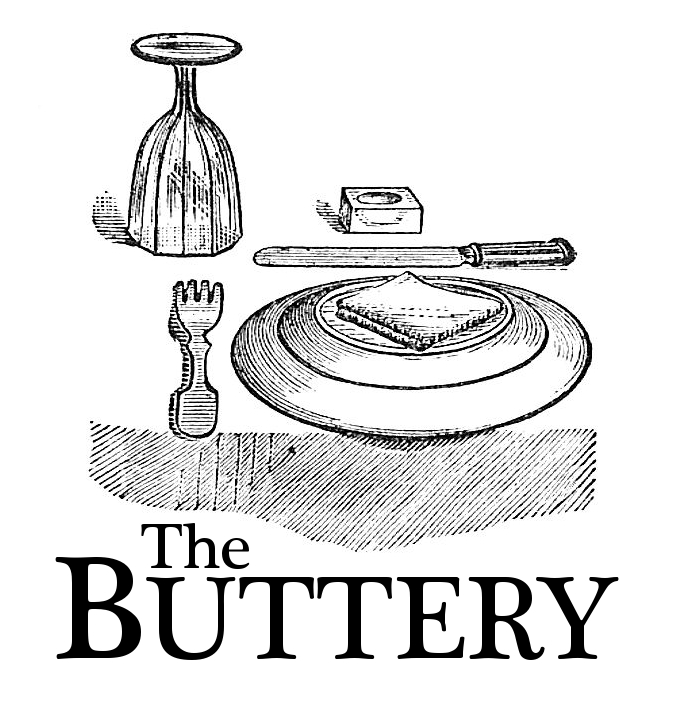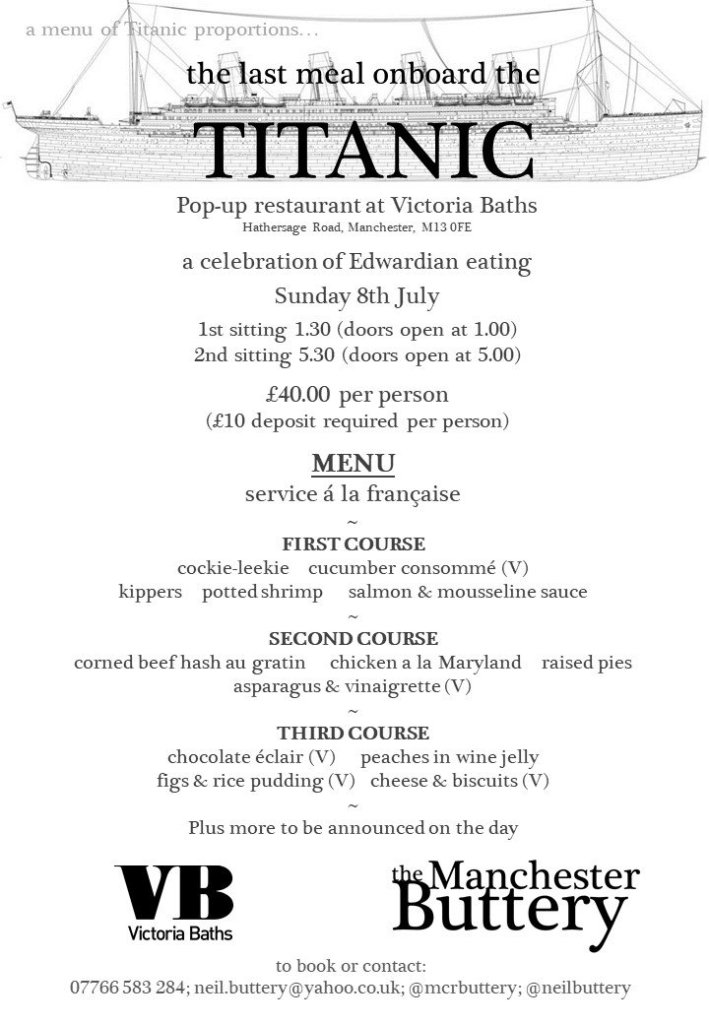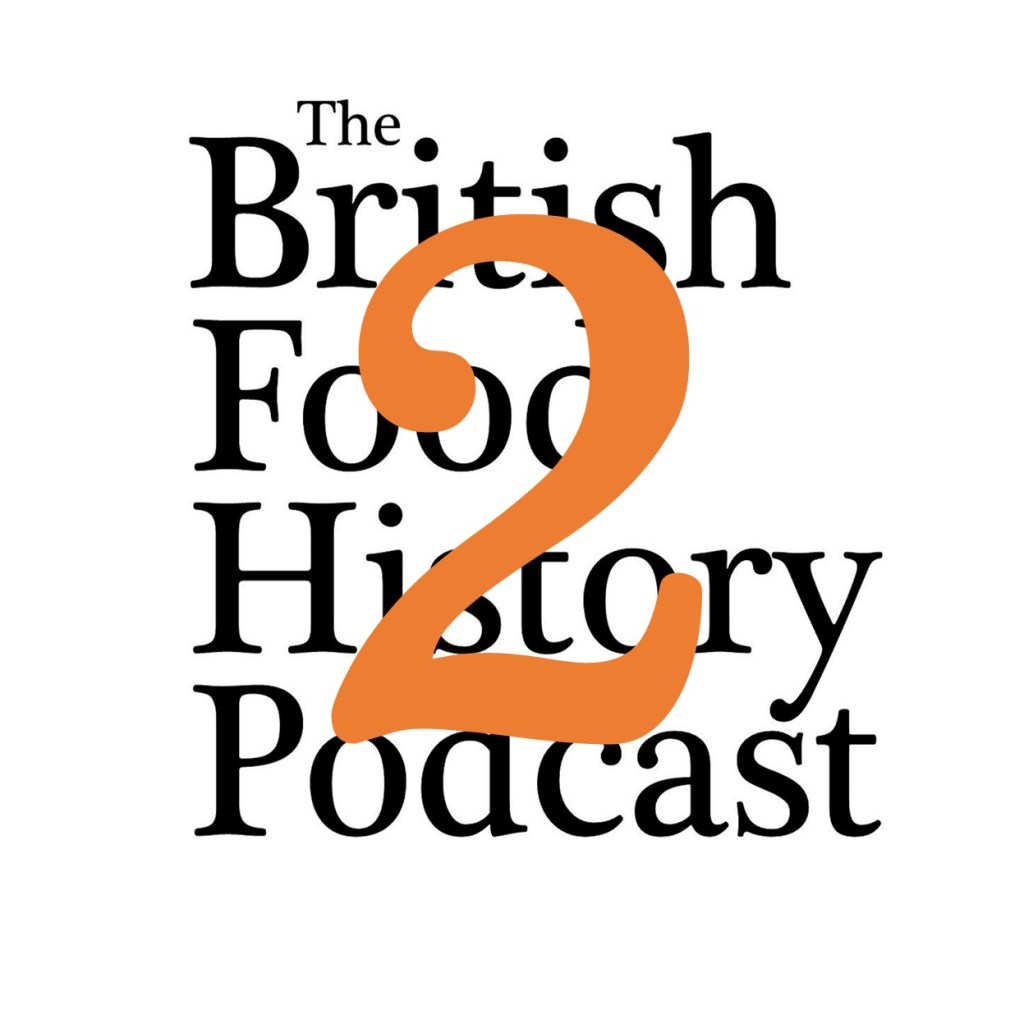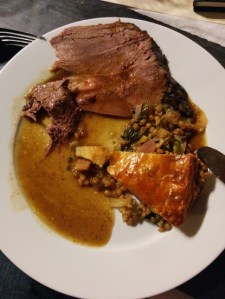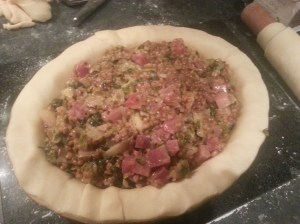Hello! I thought some of you might be interested in a post I just published on the other blog, Neil Cooks Grigson.
Tag Archives: Jane Grigson
Singin’ Hinnies
In my book Knead to Know: A History of Baking, I made sure that there was a full chapter focussing on griddlecakes: food baked on hearthstones, bakestones and iron griddles. Of course, when writing the chapter, I took much inspiration from Jane Grigson’s baking recipes in English Food. I was surprised by the great variety. These days the English barely think beyond the crêpe.
It’s been a while since I posted a recipe for a griddlecake, and I have had this one, for singin’ hinnies, waiting in the wings for a while. These little cakes are a rather forgotten speciality of Northumberland. I first made these for the Neil Cooks Grigson project in its very early days and I didn’t do a great job of interpreting Jane’s recipe.[1] I have improved greatly since then. The real prompt to get this recipe out there was my conversation with Sophie Grigson, Jane’s daughter, for a recent episode of The British Food History Podcast all about Jane’s work. The topic of singin’ hinnies cropped up because Jane’s entry for it in English Food is particularly evocative. Listen to the episode here:
These griddlecakes, enriched with lard and butter and sweetened only by dried fruit, were eaten by all, and were especially at children’s parties where tuppeny and thruppenny pieces were hidden inside.[2] These once ubiquitous cakes were, for many families, sadly the ‘substitutes for the birthday cake [they] could not afford.’ The word ‘hinnie’ is a dialect one for honey, a term of endearment, and the ‘singin’’ refers to the comforting sizzle of the butter and lard from the cooking griddlecakes, although Jane does point out that ‘the singin’ hinnies made less of a song for many people as they could not afford the full complement of butter and lard.’[3]
I have found other mentions of singin’ hinnies elsewhere but recipes and descriptions are very vague. I did find two nineteenth-century descriptions that really emphasised their importance at the dinner tables of miners – Northumberland being very much a colliery county. The job required very calorific food, so these griddlecakes served an important function. One stated that ‘miner’s food consisted of plum pudding, roast beef and “singing hinnies”.’[4] Another, written by J.G. Kohl, a German travel writer, informs us that ‘[the colliers] even have dishes and cakes of their own; and among these I was particularly told of their “singing hinnies”, a kind of cake that owes its epithet “singing” to the custom of serving it hissing hot upon the table…They are very buttery, and must never be absent on a holiday from the table of a genuine pitman.’[5]
Jane reckons they are the second-best British griddlecake; for her, Welsh cakes take the top spot.
If you like the blogs and podcast I produce and would to start a £3 monthly subscription, or would like to treat me to virtual coffee or pint: follow this link for more information. Thank you.
Recipe
I give you my interpretation of Jane’s recipe with more precise ingredients and method. I have found all other recipes to be either too vague in the amount of liquid that should be added, or, when specific, far too dry. I do hope you find this recipe clear; I know it must work because the hinnies sing loud and true as they cook on the griddle.
A proper singin’ hinnie should be made with equal amounts of butter and lard. If you are vegetarian, avoid using shortening such as Trex, instead go posh and use all butter.
Makes 24 to 28 griddlecakes
500 g plain flour, plus extra for rolling
1 tsp baking powder
¾ tsp salt
125 g lard, diced
125 g butter, diced
180 g dried mixed fruit
220-240 ml milk
Extra lard for frying
Extra butter for buttering the insides of the singin’ hinnies
Mix the flour, baking powder and salt in a bowl, then rub in the lard and butter until the mixture resembles breadcrumbs, then add the dried fruit and mix again.
Make a well in the centre, add most of the milk and mix to make a nice soft dough – it’s a good idea to use the old-fashioned method of combining everything using a cutting motion with a butter knife; that way you ensure the liquid is combined with the other ingredients without overworking the gluten in the flour. Add the remaining milk should there be any dry patches.
Lightly flour your worktop and knead the dough briefly so that it becomes nice and smooth. Let it rest as you get your bakestone, griddle or pan ready.
Place the bakestone on a medium heat and allow to get to a good heat; because there is no sugar in the mixture, the cakes don’t burn easily.
As you wait for it to heat up, roll the dough on a lightly floured surface to a thickness of around ¾ centimetre and cut out rounds. I used a 7-centimetre cutter, but 6- or 8-centimetre cutters will be fine. You might find it easier to cut them out if you dip your cutter in flour and tap away any excess. Reroll the pastry and cut out more.
Take a small piece of lard, quickly rub it over the surface of the bakestone and cook your first batch: mine took 5 to 6 minutes on each side to achieve a nice golden brown colour on the outside and a fluffy interior (I sacrificed one to check inside). Split each one with a knife and add a small pat of butter, close and keep them warm in the oven on a serving plate as you cook the rest.
Serve warm with your favourite toppings. I went with good old golden syrup (and an extra knob of butter).
Notes
[1] Read the original post here.
[2] i.e. two-penny and three-penny coins.
[3] Grigson, J. (1992) English Food. Third Edit. Penguin.
[4] Fynes, R. (1873) Miners of Northumberland and Durham. J. Robinson.
[5] Kohl, J.G. (1844) England, Wales and Scotland. Chapman and Hall.
Madeira Cake
I have been thinking and reading about baked goods rather a lot this year, having written Knead to Know: A History of Baking (out 12 September, preorder here). One thing I mention in the book is the activity we in Britain no longer partake in: dipping little sponge cakes in sweet alcoholic drinks. The closest we get to this is when we soak them in booze for a trifle, but fewer and fewer of us are making traditional trifles these days, I’d say.[1] Cakes made especially for dipping are well known: financiers, madeleines, boudoir biscuits (which are actually dry cakes). We used to dunk cake in wine though, and even came up with one of our own (the ones listed above are all French in origin); the now rather passe Madeira cake. It’s dismissed as a rather dry, plain sponge cake,[2] and perhaps it is, but that’s because we are no longer consuming it in the way it was designed to be, as Jane Grigson tells us in English Food, ‘this cake was served with Madeira and other sweet wines in the nineteenth century.’[3]
Madeira is a sweet wine made on the island of the same name (sugar was made there in the early modern period[4]), and it was a popular export to Britain from the seventeenth century.[5] The first time recipes for cakes specifically made for dipping in wine pop up in handwritten manuscripts from the eighteenth century, and the first printed recipe for Madeira cake (according to Laura Mason and Catherine Brown) appears in Eliza Acton’s 1845 classic Modern Cookery for Private Families.[6]
To produce a cake that can be successfully dipped without breaking up, it must be made on the dry side compared to, say, a pound cake or Victoria sponge: more flour is used, and no extra liquid is added (there’s no dropping consistency here). Whilst searching the internet for recipes, I spotted that people commonly search for ‘moist Madeira cake’ recipes. Well there is no such thing, it isn’t supposed to be moist. Yes, there are recipes to be found on the internet for apparently moist Madeira cakes that include additional ground almonds, milk and/or a reduced amount of flour. Well, you can do that, of course – be my guest, it will be delicious I’m sure – but it will no longer be a Madeira cake.
Creating lift is very important when it comes to sponge cake-making, and in Eliza Acton’s recipe, it is achieved by whisking eggs and sugar until frothy, before folding in flour mixed with a little ‘carbonate of soda’, and then cold, melted butter.[7] We’d call this a genoise-style cake these days. Recipes today use the more familiar creaming method and more raising agent, but don’t be tempted to use self-raising flour – that would give the mixture too much of a boost; we’re aiming for small, densely packed, bubbles here, so a more restrained amount of baking powder is required.

Older recipes ask for Madeira cake to be cooked in a round tin (or hoop), but I prefer baking mine in a 900 g (2 lb) loaf tin.[8] I like the characteristic crack you get that runs down the length of the baked cake. Very pleasing. When it comes to flavouring, just a little lemon zest is traditional. Some ask for a decoration of candied citron strips, but I don’t think it’s necessary.
This recipe is adapted from the one given by Jane Grigson in her classic tome English Food,[9] first published in 1974, making it 50 years old this year!
If you like the blogs and podcast I produce and would to start a £3 monthly subscription, or would like to treat me to virtual coffee or pint: follow this link for more information. Thank you.
175 g softened, salted butter
175 g caster sugar
275 g plain flour
1 level tsp baking powder
4 large eggs (or 4 medium eggs + 1 tbs milk)
Grated zest of a lemon
Preheat your oven to 160°C, then line a 900 g (2 lb) loaf tin with baking paper.
Beat the butter and sugar until light and fluffy with your beaters, a most important stage as it seeds lots of air bubbles in the batter, making for a lighter cake. Now crack the eggs into the mixture one at a time: put the beater on a medium speed, add your first one, and when fully combined, add the next. If the egg and butter mixture begins to curdle (and it probably will after egg number two), add a spoonful of flour and beat on a medium-high speed until incorporated fully, then continue until all of the eggs are used up.
Mix the flour and baking powder, and tip into the mixture along with the lemon zest. Stir on a slow speed until the mixture is smooth. If your beater’s slow speed isn’t that slow, it is better to mix in the flour by hand. If you used medium eggs, add the milk at this point and mix into the batter.
Spoon the mixture into the lined loaf tin and level off. Bake for 1 hour (though check after 50 minutes) until cooked through. Do the good old test of pressing the cake with a finger: if it springs back, it is ready. You can always skewer the cake with a wooden toothpick to see if it comes out clear of any uncooked batter.
When ready, cool in the tin on a wire rack. Best eaten within the first 24 hours of baking.
Notes
[1] In Britain, the only thing we’re dunking is our biscuits in our tea.
[3] Grigson, J. (1992). English Food (Third Edit). Penguin.
[4] This is covered in Buttery, N. (2022). A Dark History of Sugar. Pen and Sword History.
[5] Mason, L., & Brown, C. (1999). The Taste of Britain. Harper Press.
[6] Ibid. I searched too and could not find an earlier example.
[7] Acton, E. (1845). Modern Cookery For Private Families. Quadrille.
[8] Most recipes, even modern ones, describe loaf tins by the weight of bread dough they are designed to bake: 450g (1 lb) or 900g (2 lb). Exact dimensions vary, but in the case of a 900g (2lb) tin, the dimensions are around 21 cm long x 11 cm wide x 7 cm high.
Quick & Easy Puff or Rough Puff Pastry
I have to admit something: I have never made proper puff pastry. If a recipe calls for it, I buy some or make rough puff pastry instead, and I tell myself that I have neither the time nor the space to go ‘full-puff’. The truth, I think, is that I don’t have the inclination, otherwise I would have got around to it by now. Modern puff pastry is made by rolling out a rectangle of dough, then sitting atop it a square of butter, thoroughly beaten flat with a rolling pin. The dough is folded around the butter, the dough and butter are then rolled out, rotated 90 degrees, folded, then rested and chilled. This single ‘turn’ is repeated six more times to produce a laminated pastry dough containing 729 layers of butter.
Rough puff pastry, on the other hand, is not made with a single layer of folded butter, instead very cold diced or grated butter is used, a non-continuous layer of butter means that those great sheets of crispy pastry are not made, hence rough puff, or flaky, pastry. The process of making it is similar to puff, except there are fewer turns, though it still needs to be rested in the fridge between them. My method (see below) is much easier than this, however.
The differences and semantics break down if we hit the historical cookbooks because at one point all ‘puff pastes’ were what we would call ‘rough puff’ today. There are many stories and theories regarding who invented puff pastry and when, and they are either apocryphal or impossible to confirm. When it comes to British cookery books, the earliest example I can find is the late Tudor classic The Good Houswifes Jewel by Thomas Dawson (1596). Here, a dough made from flour, water, egg yolks and some rubbed-in butter, is rolled out, peppered with diced butter, folded and rolled. More butter is added after each turn. This basic method seems to remain the same for the next two-and-a-half centuries: Sarah Harrison (1751), Elizabeth Raffald (1769) and Eliza Acton (1845) all have puff pastry recipes just like it.[1] The first time I find a puff pastry recipe that uses a single layer of bashed-out butter is in Alexis Soyer’s classic A Shilling Cookery for the People (1855 edition).
I admit that my search was not a comprehensive one, but I think it’s safe to say that in recipes older than c.1850 if puff pastry is asked for, what we should be making is a rough puff.
If you like the blogs and podcast I produce and would to start a £3 monthly subscription, or would like to treat me to virtual coffee or pint: follow this link for more information. Thank you.
Recipe
My recipe is based on a Jane Grigson’s for Quick, Foolproof Puff or Flaky Pastry, from her book English Food,[2] which is, in turn, adapted from a recipe by New York pastry chef Nicholas Malgieri. I’m not sure if it is foolproof, but it is by far the easiest method I know. The reason for this is that the cubes of very cold butter are mixed into the dough. As you roll and fold, you can see the cubes of butter eventually turn into large, flat discs within the dough. Very satisfying. Mixing the butter into the dough itself also means that the butter is evenly distributed and doesn’t end up leaching out of the sides.
I have given instructions to make this dough by hand, but you can use a machine. However, you must mix the ingredients very slowly and add liquid in a steady stream, so the lumps of butter don’t turn into breadcrumbs.
This type of rough puff pastry doesn’t need to be rested between rolling and folding unless it is very hot where you are, then you may need to pop it in the fridge for 15 minutes or so between turns.
This pastry only needs two ‘turns’ before it is ready for rolling and use, however, if you want a pastry that is just flaky, then do a third turn before rolling it out for use.
250 g strong white flour, plus extra for dusting
½ tsp salt
250 g very cold, unsalted butter, cut into 1 cm dice (approx.)
Juice of half a lemon
Water (see recipe)
Mix the flour and salt and add the butter, squashing the pieces between your thumb and forefinger, without rubbing them in or breaking them up.
Next, place a jug on a weighing scale add the juice from the lemon and then top up to a weight of 125 grams.
Stir in most of the liquid to form a ball of dough, using the remainder to pour on any dry-looking patches of flour.
Bring the dough together into a single mass and place on a well-floured worktop. It will look a right mess, but do not worry, it will neaten up in the rolling and folding stage.
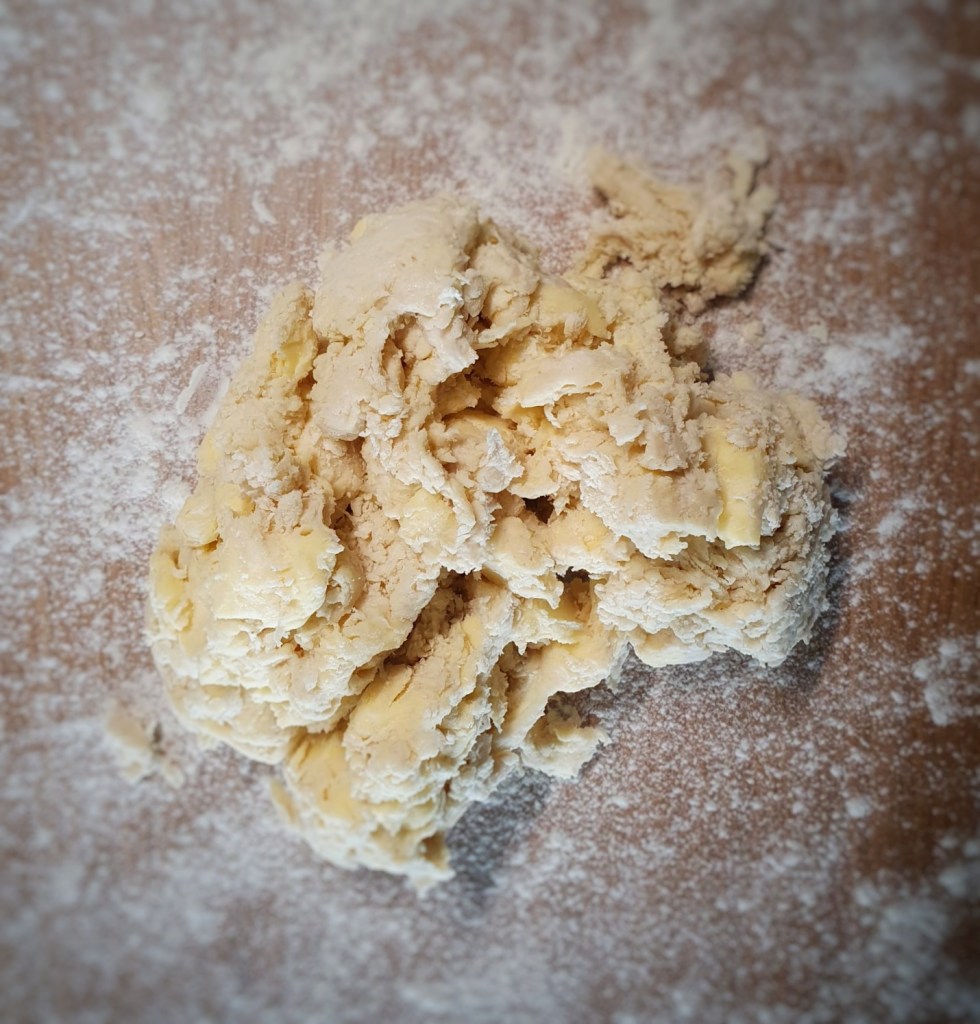
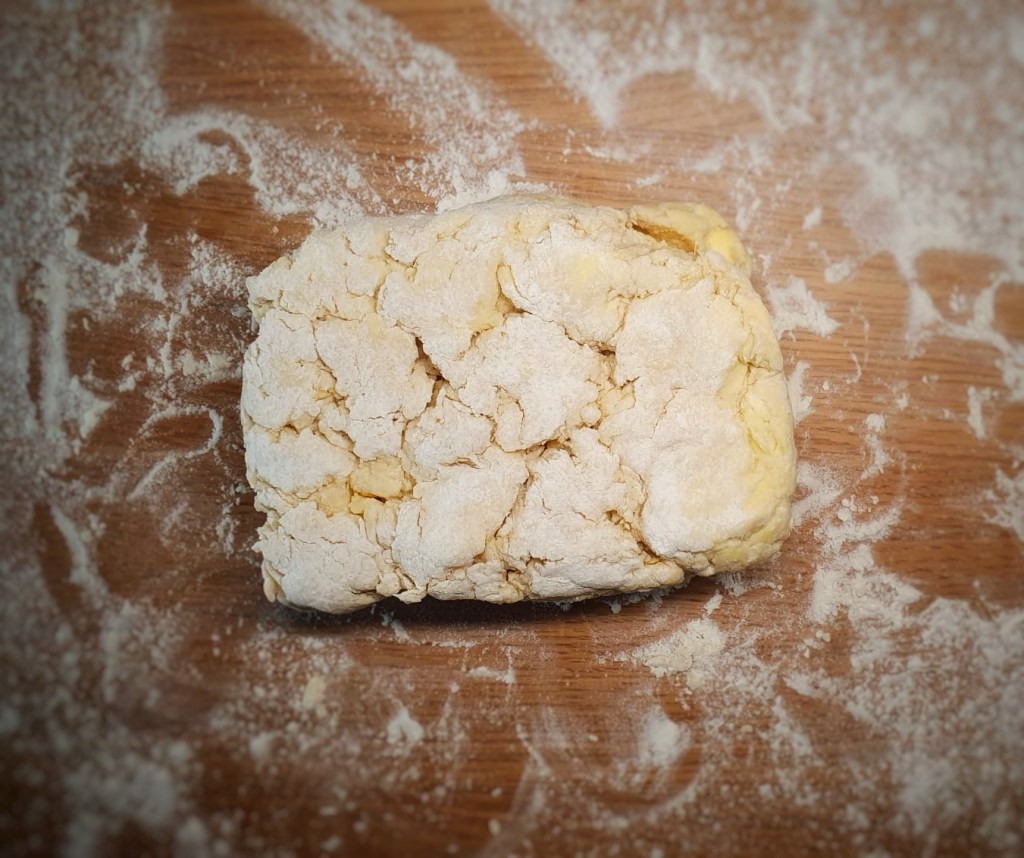
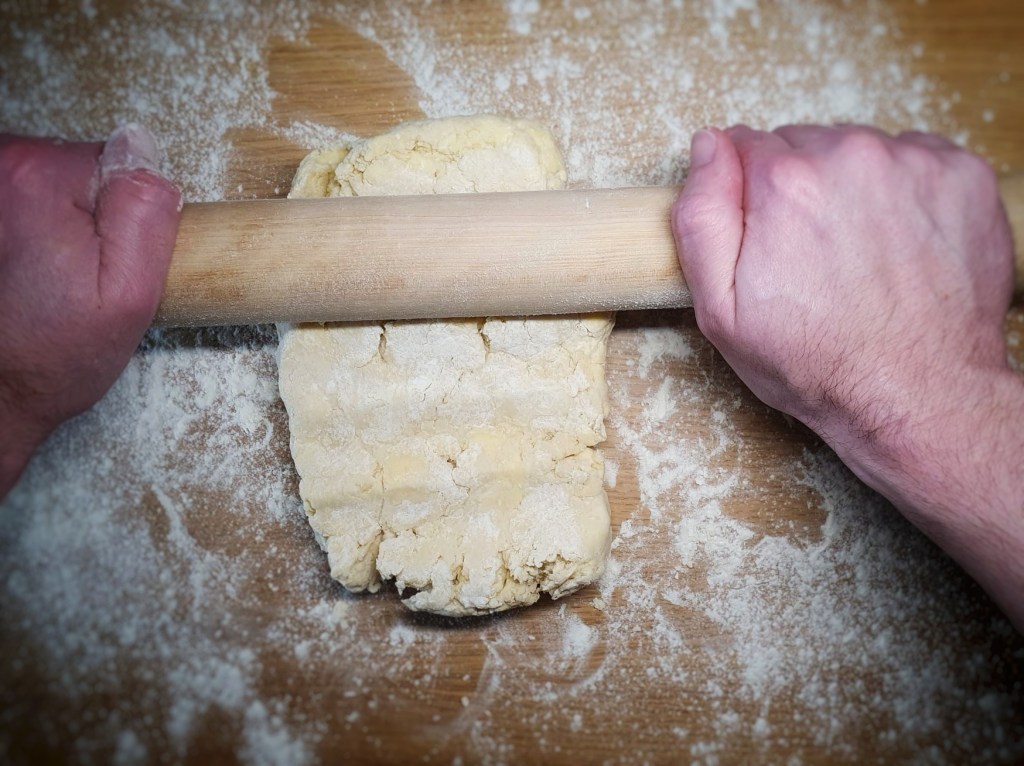
Shape it into an approximate rectangle, then use a rolling pin to roll it into a large rectangle around 30 cm wide and 20 cm deep. Ensure you keep your work surface well-floured because the dough is quite sticky at first.
Now fold the sides into the centre of the rectangle and then fold it in half, so it looks a little like a book. Allow it to rest for 2 minutes.
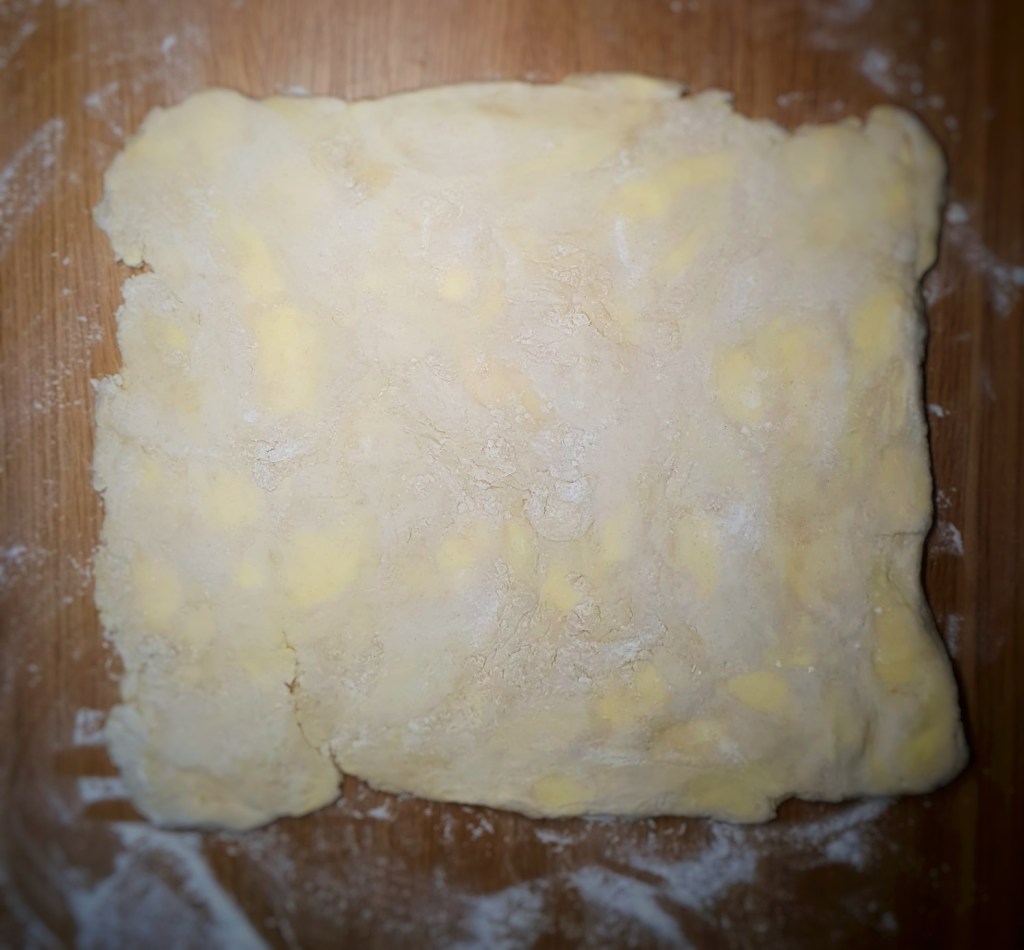

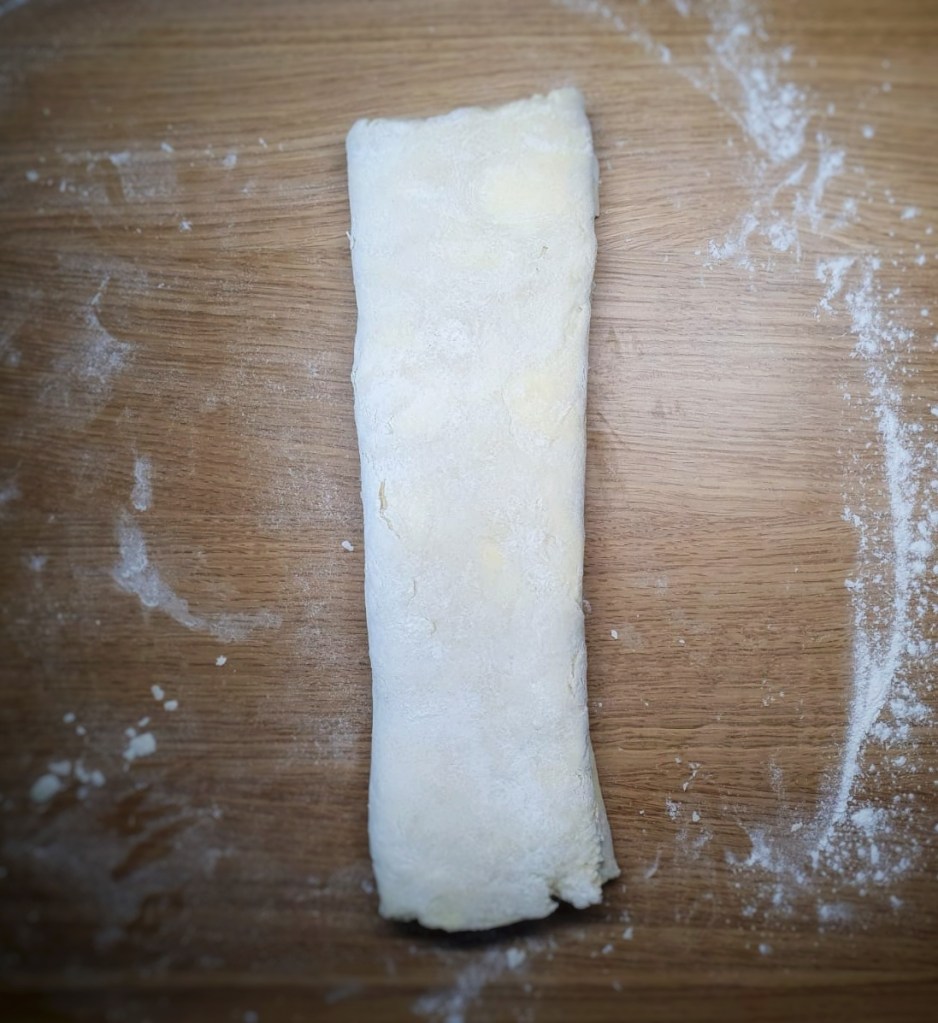
Turn it 90 degrees clockwise and then roll it out again, roll it out thin enough to flatten the cubes of butter.
Fold up and roll out one more time, before wrapping in cling film and allowing it to rest in the fridge for 30 minutes, and roll out as required.

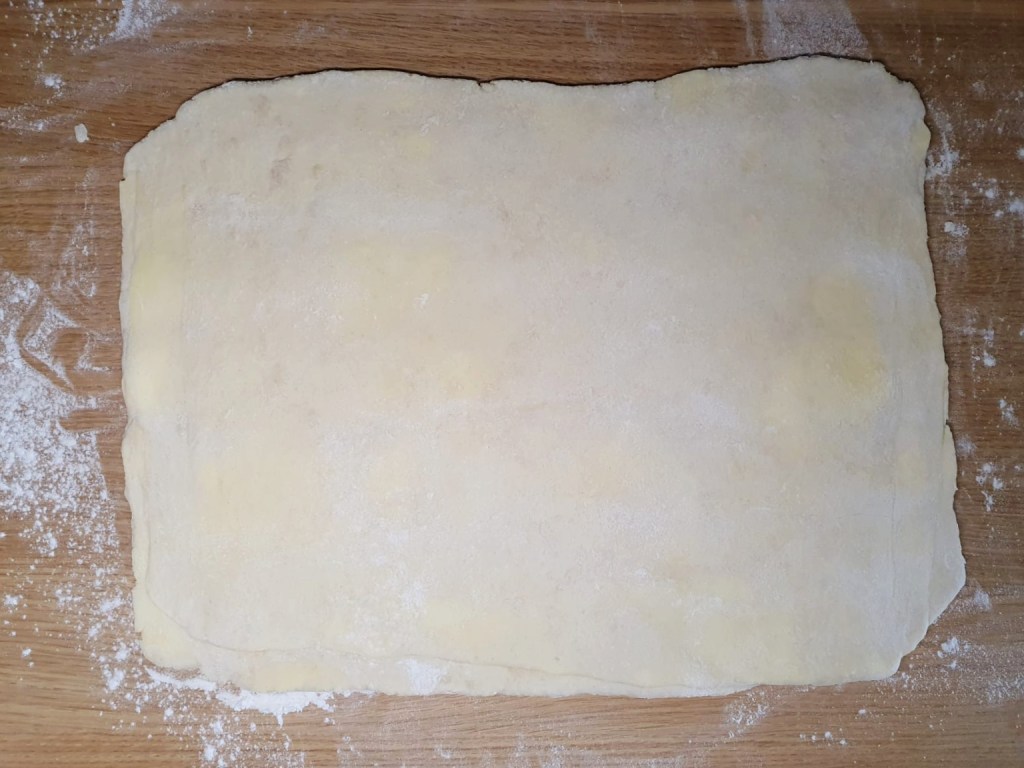
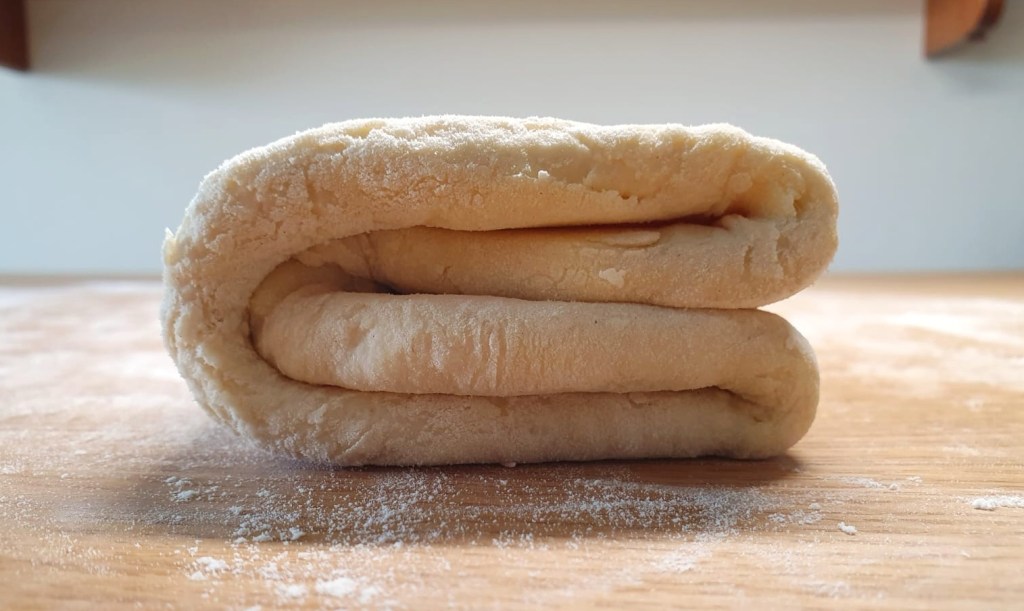
Notes:
[1] i.e., Harrison, S. (1751) The House-keeper’s Pocket-book And Compleat Family Cook. 5th edn. R. Ware; Raffald, E. (1769) The Experienced English Housekeeper. First Edit. J. Harrop; Acton, E. (1845) Modern Cookery For Private Families. Quadrille.
[2] This is the third edition: Grigson, J. (1992) English Food. Third Edit. Penguin.
Filed under baking, Britain, cooking, Eighteenth Century, food, General, history, Recipes, Uncategorized
‘Before Mrs Beeton: Elizabeth Raffald, England’s Most Influential Housekeeper’ – out February 28 2023
I am very pleased to announce that my second book, a biography of the 18th century cookery writer, entrepreneur and Manchester legend Elizabeth Raffald will be published in the UK on 28 February 2023. It is called Before Mrs Beeton: Elizabeth Raffald, England’s Most Influential Housekeeper and is published by Pen & Sword History. North American readers: I’m afraid you’ll after wait until 28 April before you can get your hands on a copy. Rest of world: please check with your favourite bookshop.
Before I tell you more about the book, I thought I’d let you know that if you pre-order via Pen & Sword’s website (so there’s not long left) you can get 20% off the cover price. The book is, of course, available from other booksellers. I will be selling some copies too, which of course will be signed by Yours Truly.
I’ll be posting all sorts about Elizabeth and 18th century food throughout March on the blog and on social media, so if you don’t follow me already on social media, now is the time to do so. I am @neilbuttery on Twitter, dr_neil_buttery on Instagram and my Facebook discussion group can be viewed here.
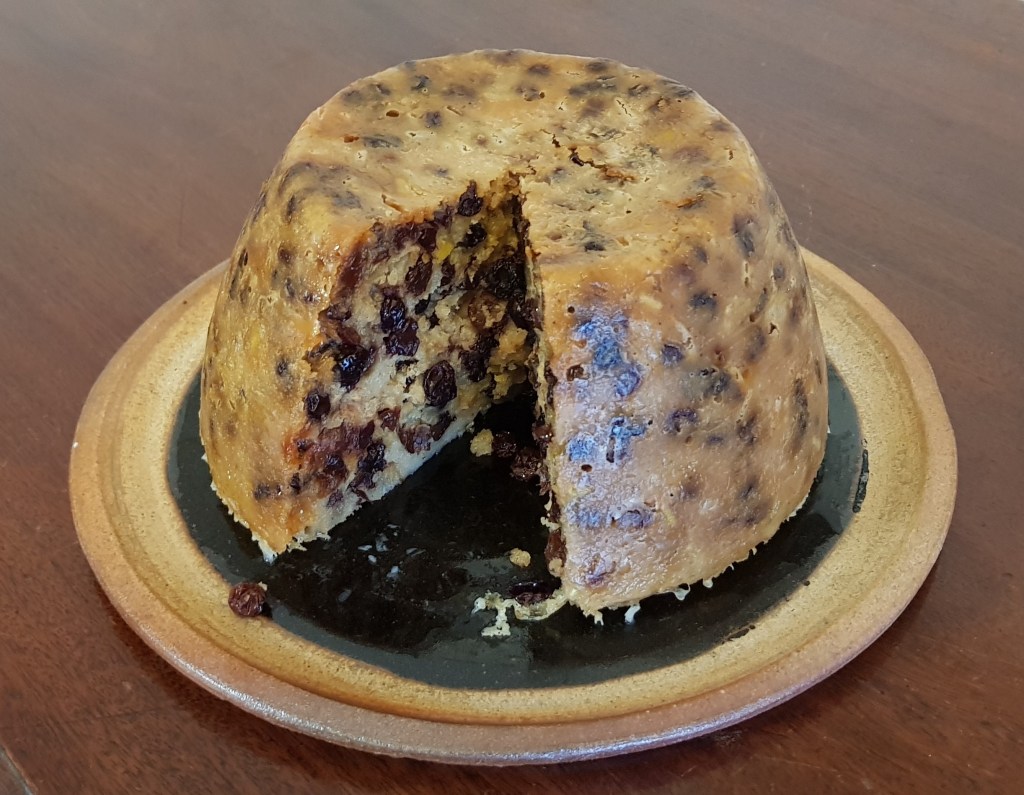
The book charts Elizabeth’s many achievements and life events, the best known being the publication of her influential cookery book The Experienced English Housekeeper in 1769 – but there are many, many others. Her life was a dramatic one: starting life in domestic service, she rose to fame and fortune and transformed Manchester’s business community, before a tumultuous fall. Her book outlived her, but its popularity had a great rise and fall too.
I discovered Elizabeth via Jane Grigson, and it is these two food writers who have been my biggest, and most constant inspiration through 15 years of researching and cooking British food, and I am so happy to be the one to write Elizabeth’s biography.
Mrs Beeton’s name is in the title for a variety of reasons, the main one of which being that it is Elizabeth – a full century before Beeton and her book – who defined what we think of today as traditional British food, not Isabella Beeton, yet it is Beeton who is placed on that pedestal.
To find out more about the book, listen to this recent podcast about Elizabeth, her life, and more about why Mrs Beeton has a lot to answer for!
The Return of the British Cheese Industry
This post complements the episode ‘Cheddar & the Cheese Industry’ on The British Food History Podcast:
Britain’s cheese industry has certainly been through its peaks and troughs over the centuries. As Peter Atkins and I discuss in the podcast episode Cheddar & the Cheese Industry there was once a great variety of local cheeses, but as urban populations grew and there was the need for cheap cheeses for the masses, Britain underwent a cheese bottleneck. The reason? The ‘cheddarfication’ of the industry: our lovely Cheddars were stripped of their character in the 19th and 20th centuries, massed produced and insipid. Not only that, but other cheeses became more like Cheddar, i.e. sharper and harder: Cheshire, Dunlop and Wensleydale all became more like Cheddar. The latter, now a mild and curdy cow’s milk cheese was once a soft, blue ewe’s milk cheese! Writing in the 1950s, Dorothy Hartley thought our cheese industry was dead: ‘the sub-standard cheese is so poor that it invites contrast; so the good cheese standard must be lowered till both are “standard mediocre”. The industrial revolution of the dairy is complete! And our really fine cheeses are lost to England.’1
But then old cheeses and old methods returned with gusto from the late 1980s. How? You’ll have to listen to the podcast! Writing in the 1990s in the third edition of her book English Food, Jane Grigson was impressed by the ‘marvellous choice’ available by the end of the 20th century: ‘One of the happy developments since I wrote [the first edition of] this book has been the renaissance of cheesemaking in Britain.’2 She was particularly happy about the raw milk cheeses, and chesses made with ewe’s and goat’s milk. I’d like to add more soft cheeses and proper full-flavoured hard cheeses.
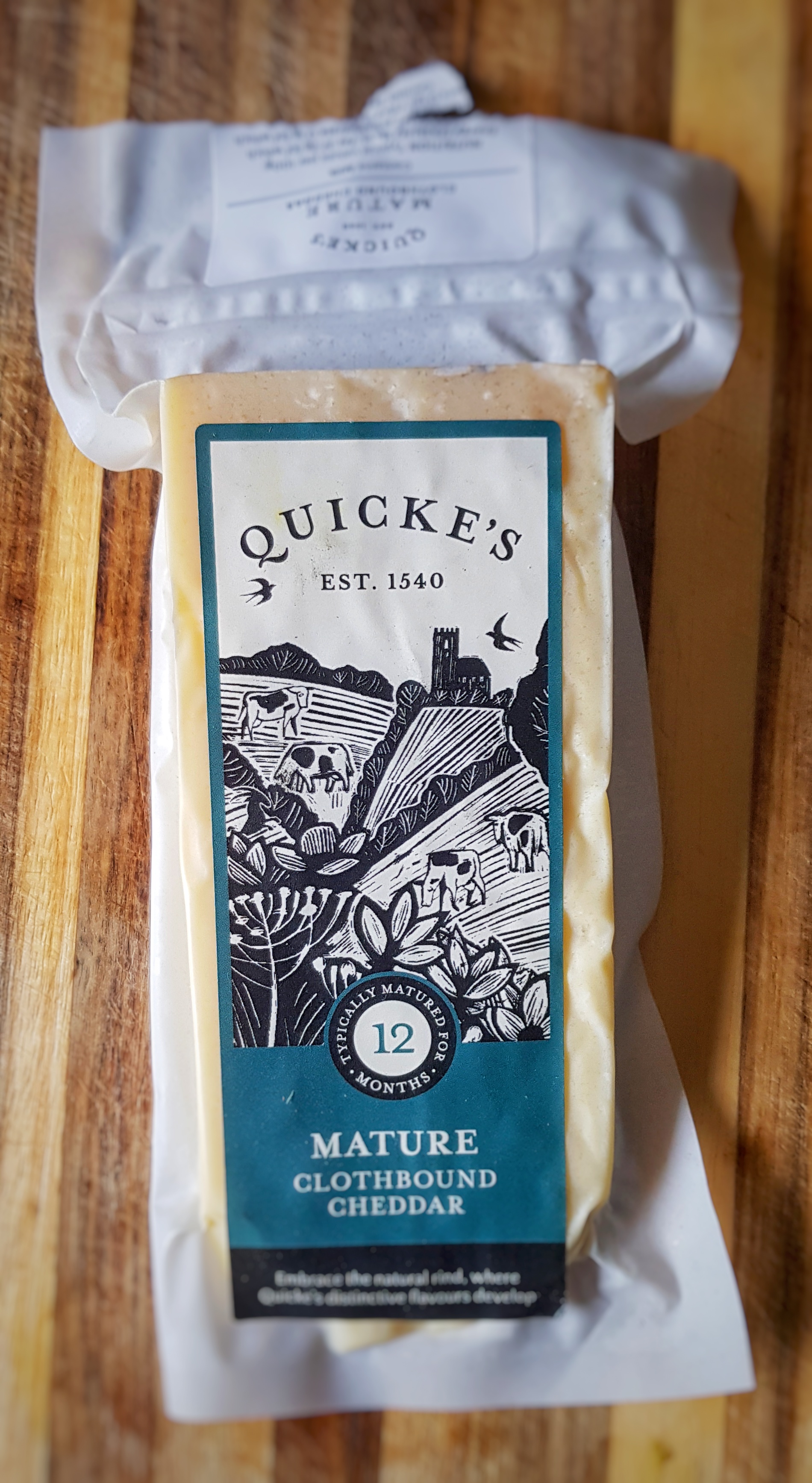
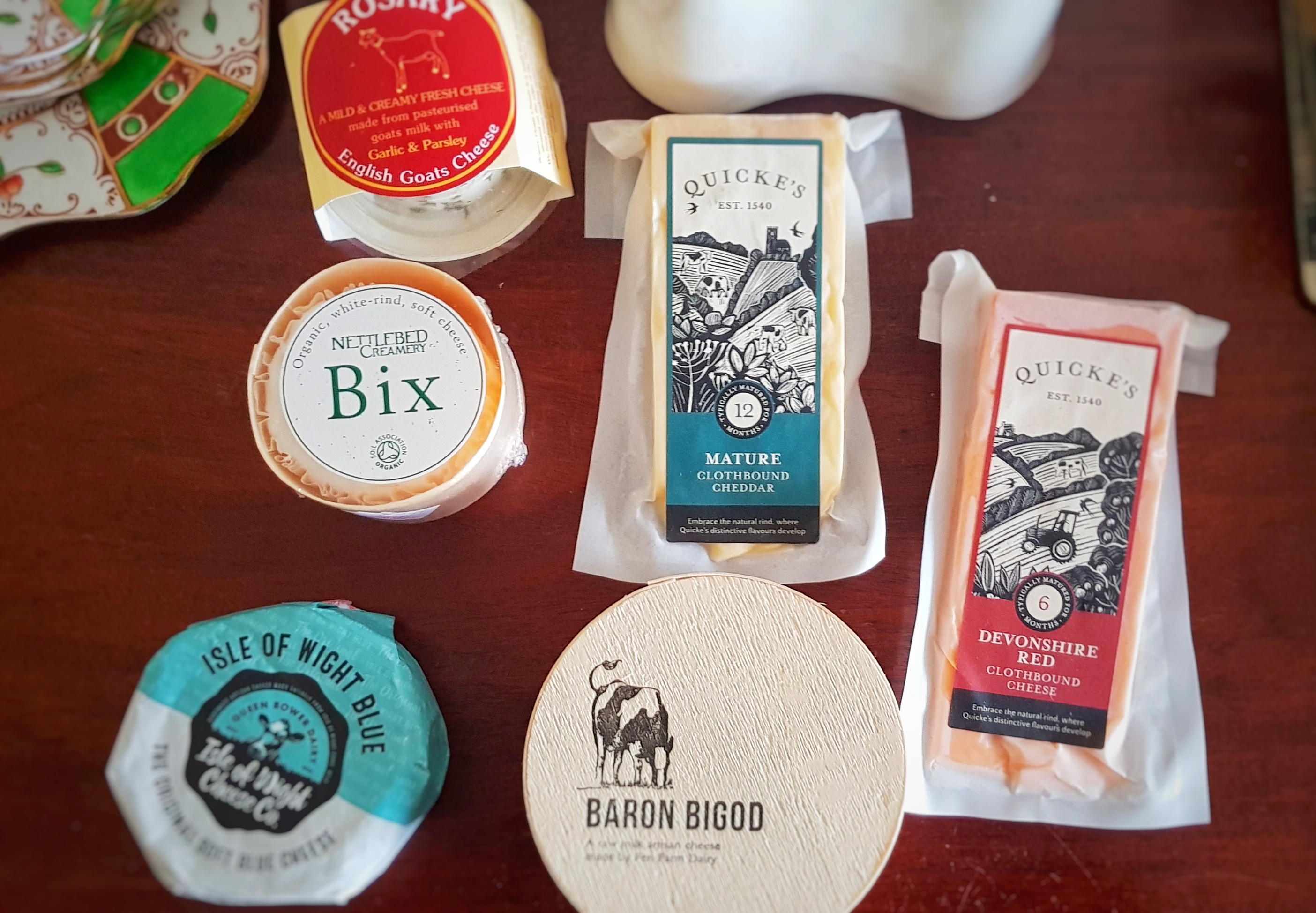
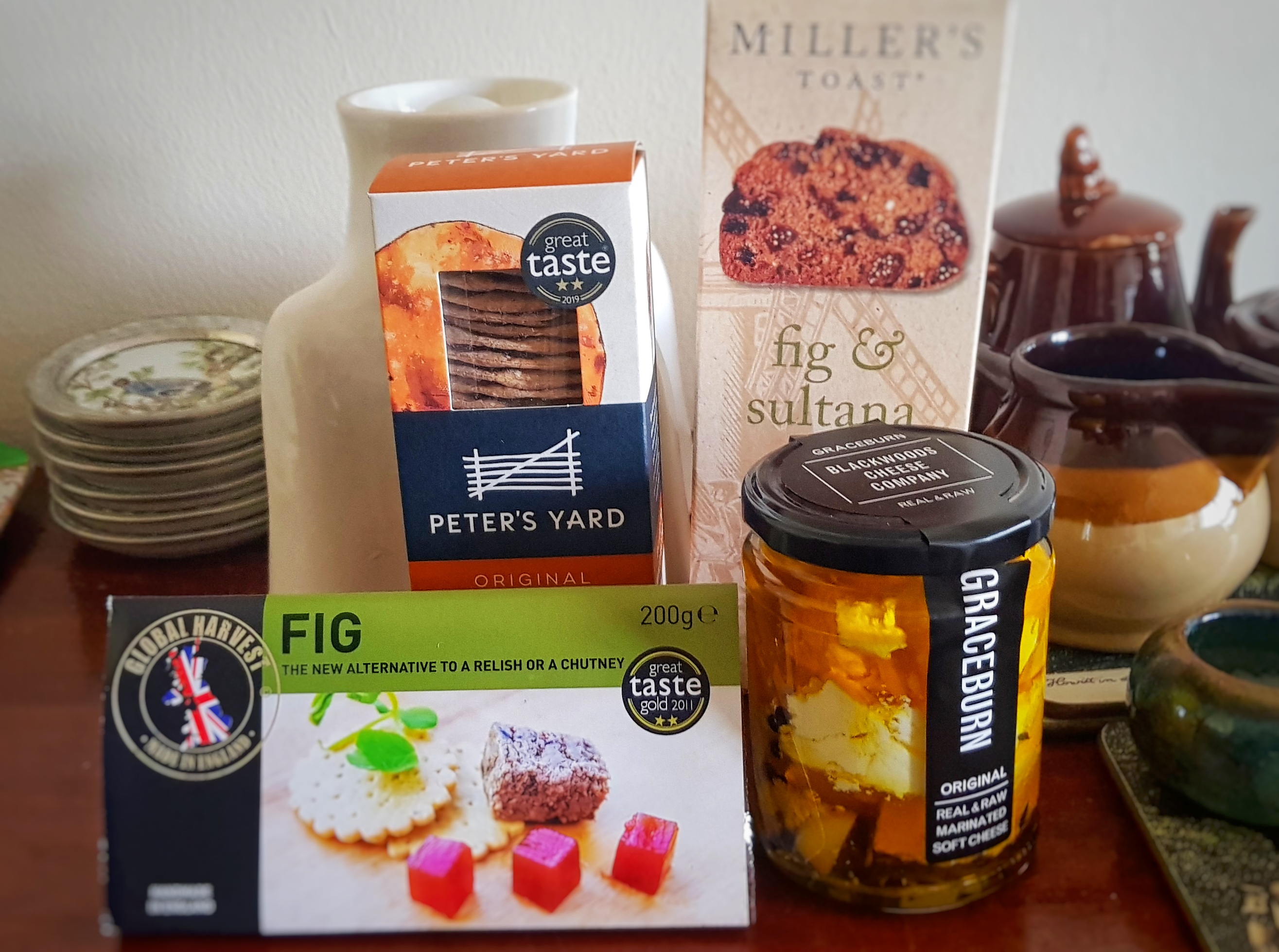
You are not going to find these cheeses in your local supermarket: you need a good purveyor. I can highly recommend Harvey & Brockless. They have some excellent cheeses, in fact some of my absolute all-time favourites. They sent me a selection of British cheeses through the post, and I must say I was impressed.* It wasn’t just the quality but the fact there was the full gamut of historical and traditional cheeses represented: a Romanesque fresh goat’s milk cheese (Rosary), a cheese that could have been Anglo-Saxon (Bix, a raw creamy cow’s milk cheese), my favourite blue cheese of all time (Isle of Wight Blue; just divine). There was too the oozy and very ripe Baron Bigod, and some traditional cheesecloth matured Cheddar and Devonshire Red (both by Quicke’s). There was even a jar of salty raw goat’s cheese in a herby and garlicky oil (Graceburn) which I made into a salad using the oil to make the dressing – excellent!
Eating Cheese
Excellent cheeses such as these require little help. It’s important you allow your cheese to come up to room temperature under a cheese cloche (or upturned bowl). Proper cheese is a living breathing community of bacteria and fungi and it can sit happily under cover for 2 or 3 days in a cool cupboard or larder.
Eat with simple crackers (H&B provided me with Fig & Sultana Toasts from the excellent Millar’s, and Peter’s Yard Sourdough Crispbreads) or good bread, oatcakes and digestive biscuits (recipe coming soon!). In Yorkshire cheese is eaten with fruit cake, apple pie and gingerbread. Add equally simple accoutrements such as fruit jellies, chutneys or pickles.
Cheese Recipes
Using great cheeses in your cooking improves dishes immeasurably and I thought I’d provide you with a couple of good recipes that makes a small amount of cheese go a long way: a historical toasted cheese and a blue cheese ice cream which is excellent served with poached pears and home-made spelt digestives (that one will be coming in the next post).
Lady Shaftsbury’s Toasted Cheese
This is a recipe I have adapted slightly from Jane Grigson’s English Food. Jane was fortunate to receive the ‘receipt’ book that belonged to Emily Shaftesbury ‘wife of the great social reformer, the seventh Earl of Shaftesbury’. They were relatively poor, at least as far as the aristocracy go, and were always in debt.2 Because of this, many of the dishes are cheap – again, as far as the aristocracy go – and this one is delicious. It would make an excellent savoury or starter, or even a ‘light’ lunch if served with a green salad on the side.
I use inverted commas when I write ‘light’ because it is actually pretty heavy going; essentially it’s a fondue of good Cheddar cheese, egg yolks and cream that is grilled before serving with toast. The small amounts given are enough to feed four people.
A good strong melting cheese is required, and I used Quicke’s mature clothbound Cheddar. It is perfect: potent, yet creamy with just the merest hint of blue. Just one 150g piece is needed for four people.
Be warned, Jane points out that toasted cheese can cause nightmares,2 so don’t eat it too close to bedtime.**
50 g butter
5 tbs double cream
150 g grated mature Cheddar cheese such as Quicke’s mature clothbound Cheddar
2 medium egg yolks
Freshly ground pepper
Optional extras: pinch of Cayenne pepper or 1-2 tsp smooth or wholegrain mustard
4 slices of toast cut into soldiers
Preheat your grill to a medium-high heat.
Gently melt the butter in a saucepan over a medium-low heat, then add the cream, cheese and egg yolks.
Stir to combine so that the cheese melts and the egg yolks thicken the mixture to produce a smooth, thick mixture like a thick pouring custard. On no account let it boil, otherwise the cheese may split and the egg yolks scramble. Slow and steady wins the race.
As the sauce is melting, season with pepper and add the Cayenne or mustard if using.
Divide the cheese mixture between four ramekins and grill until a golden brown colour, around 3 minutes.
Serve immediately with the toast soldiers.
References
- Hartley, D. Food in England. (Little, Brown & Company, 1954).
- Grigson, J. English Food. (Penguin, 1992).
* I should point out that I am asked fairly often to do this sort of thing, but I usually turn the company/producer down, the products on offer not being my thing at all, but the brands sold by Harvey & Brockless are genuinely the ones I purchase anyway. You can be sure I would never endorse a product I didn’t think was excellent. I am no cynic!
** Cheese does not cause nightmares.
Ten Years of British Food: a History!
Well, I never expected to reach this milestone, and I certainly did not foresee what would happen in the years after I started up British Food: a History. In fact, I only set it up because my other blog – Neil Cooks Grigson – a blog created only to help me practise my writing skills after starting a PhD at Manchester University in evolutionary biology. The idea behind the blog is that I cook and blog about every recipe in Jane Grigson’s book English Food; cooking and reading her work had got me so enthusiastic about the history and tradition of British food I felt I needed a second blog! Cooking was still intended/expected only be a hobby and an escape from the laboratory, however I had started to find NCG a little restrictive: I was interested in dishes and ingredients that were not included in her book (there are no jam roly-poly, fish and chips or custard recipes for example). I had also become interested in the food and traditions of the other nations of Great Britain as well as Ireland. I was no longer tied to basing every post around a recipe either, I could write essays too.

Another reason for creating the blog was the yearning I had for all things British at the time – by now I had completed my PhD and had started a Post-Doc position in the lab of Joan Strassmann and David Queller in St Louis, Missouri, USA. I loved American culture, but being away from home focussed my own identity as a Brit, fuelling my enthusiasm for the hobby even further.
I can’t remember when the idea dawned on me that I should try and turn the cooking skills I had unwittingly gained into a food business, but off I went, back to the UK and to Manchester, with good wishes from Joan and David, and support from my friends and family – if there were nay-sayers in the camp, they were keeping their ideas to themselves. I returned to Manchester at the start of August 2012 and by the end of it I had set up The Buttery as a market stall. Under a year later I graduated up to pop up restaurant and then eventually restaurant-bar with Mr Brian Mulhearn. Busy as I was, I did try to blog, but it was tricky and I came close to stopping altogether.
The Buttery existed as a bricks-and-mortar affair for two years, but when it closed I decided to write more: it was therapeutic if nothing else, and I was at a very low ebb, so needed any help I could get. How I had missed it! Unfortunately blogging does not pay the bills, so I kept my toe in as a chef, baker and caterer.
Over the last couple of years, the blog has become much more popular and seems to be getting recognised more, leading on to a bit of TV and radio work, and I was even approached by publishing house Pen & Sword History to write my first book A Dark History of Sugar which has led to a second book, this time on a subject of my own choosing (I will let you know more about this when I can!).
The British Food History Podcast
The other project that has been borne of the blog was the Lent podcast I made with Sonder Radio and Beena Khetani. What great fun it was. I learned a lot and really wanted to get a second season made…and here it is! It’s taken me almost 18 months to organise myself, but I spotted the anniversary in my diary and thought it a good day to kick season 2 off.
I’m doing all of the writing, presenting and producing myself this time and I’ve come up with a format (I think) of separate seasons of 6 episodes. Each episode will be a standalone subject, but then use the last 2 or 3 episodes to look at a meatier subject in more depth. Kicking off season 2 today is an episode about gingerbread and my guest is the excellent writer, chef and food historian Sam Bilton, author of the cookbook First Catch Your Gingerbread.
To subscribe simply search for ‘The British Food History Podcast’ wherever you usually find your podcasts, or follow this feed to the Captivate website. Please follow, like, subscribe, rate and leave comments: I would be most grateful.
Here’s to another 10 years
What will the next decade bring I wonder? I have no idea, but one thing I do know is that I shall still be writing blog posts and putting together podcast episodes. I just love creating them, and I certainly would have given up years ago if I didn’t have such great, supportive followers on here commenting and telling me about their own memories and experiences – good and bad – on British food. So here’s a big thank you to all of you who have followed the blogs and cooked up my recipes; if I were a religious chap, I would be saying that I feel blessed right now.
I really want to carry on producing more content with more variety, but it is getting increasingly more expensive to produce online content, so if you can please support the blogs and podcast and treat me (should you think I deserve it) to a virtual coffee or pint.
If you like, for £3 per month you can also become a subscriber. If you do, you get access to premium content: extra blog posts and recipes, as well as access to my Easter Eggs tab which will soon start to fill with podcast extras: full interviews, deleted scenes and outtakes. I’m also planning to make some ‘how to’ videos demonstrating some techniques that are best taught by showing rather than by writing a long-winded method.
Right, off I go, this was only supposed to be a quick post and I’ve wittered on for ages. Here’s to the next 10 years!
If you like the blogs and podcast I produce, please consider treating me to a virtual coffee or pint, or even a £3 monthly subscription: follow this post for more information.
Filed under Blogs, food, General, Uncategorized
Baked Gooseberry Pudding
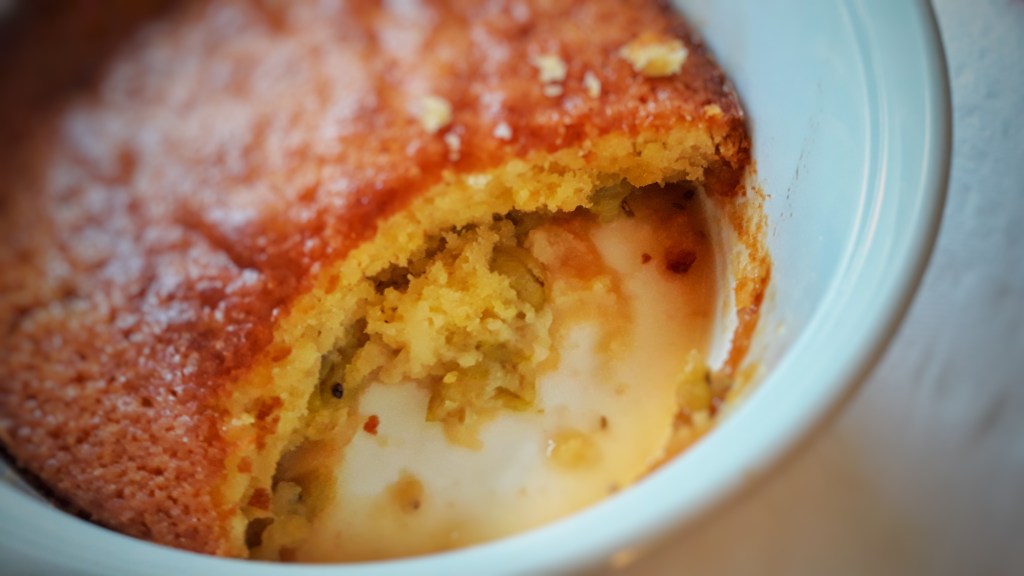
The last in a quartet of gooseberry posts – I promise I will change the subject next post.
In my honest, humble opinion this is the best gooseberry dessert recipe. It’s old-fashioned and simple to make – gooseberries are baked with a little brown sugar and a knob or two of butter, all covered in cake sponge. The berries are still very sharp and are perfectly balanced with the warm, sweet sponge. This is much more superior to the better-known Eve’s pudding – stewed cooking apples covered in sponge cake. I suspect this would work excellently with blackcurrants.
This recipe crops up in my traditional English or British cookery books, but I first heard of it from Jane Grigson (as I have many dishes) in her book English Food.
For the pudding, you can make any amount of topping, it’s dependent upon whether you like a thin or thick layer of sponge and the dimensions of your baking dish. I used a soufflé dish of diameter around 7 inches/18 centimetres. I think this is a good amount for this size, and for most family-sized dishes.
The sponge is made using the all-in-one method, so make sure your butter is extremely soft to ensure a light topping.
2 tbs Demerara or soft light brown sugar
a couple of knobs of salted butter
gooseberries, topped and tailed
100 g very soft, salted butter
100g self-raising flour
100g caster sugar
2 eggs
Set your oven to 180°C.
Scatter the sugar and dot the butter on the bottom of your baking dish and cover with the gooseberries; you are aiming for a generous single layer of them.

Place the butter, flour, caster sugar and eggs in a bowl and beat together with an electric mixer until the mixture is smooth and well-combined. Using a large spoon or spatula, add the cake batter in big spoonfuls over the gooseberries and level it, you don’t have to be very neat here, the baking batter will flatted itself out.
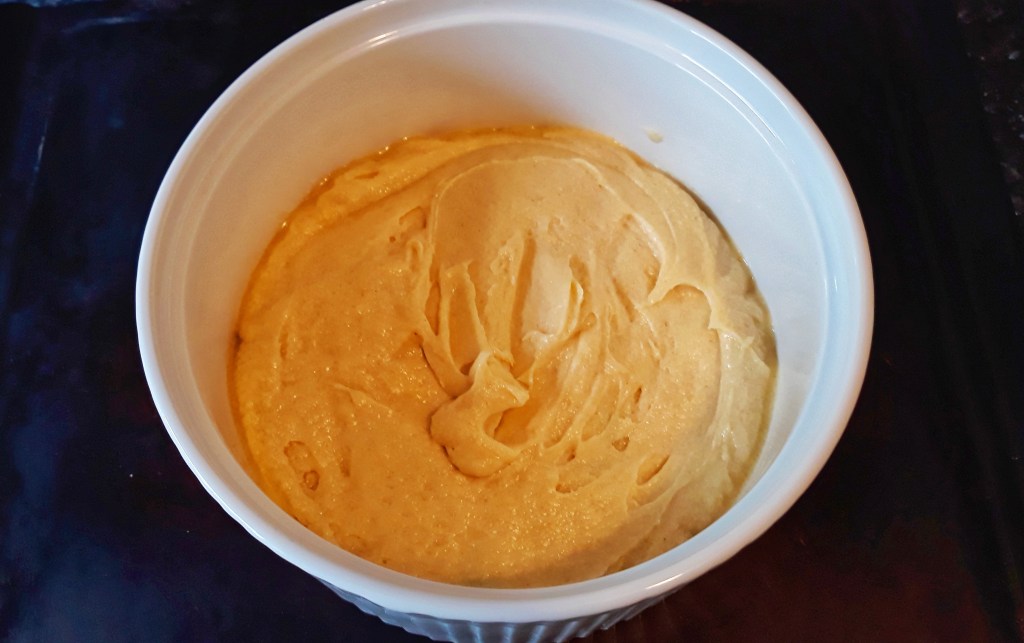
Place in the oven and bake for around an hour until the top is a deep golden-brown colour.
Serve immediately with custard or lightly-whipped cream sweetened with a little icing sugar.
If you like the blogs and podcast I produce, please consider treating me to a virtual coffee or pint, or even a £3 monthly subscription: follow this link for more information.

‘Neil Cooks Grigson’ moves to WordPress
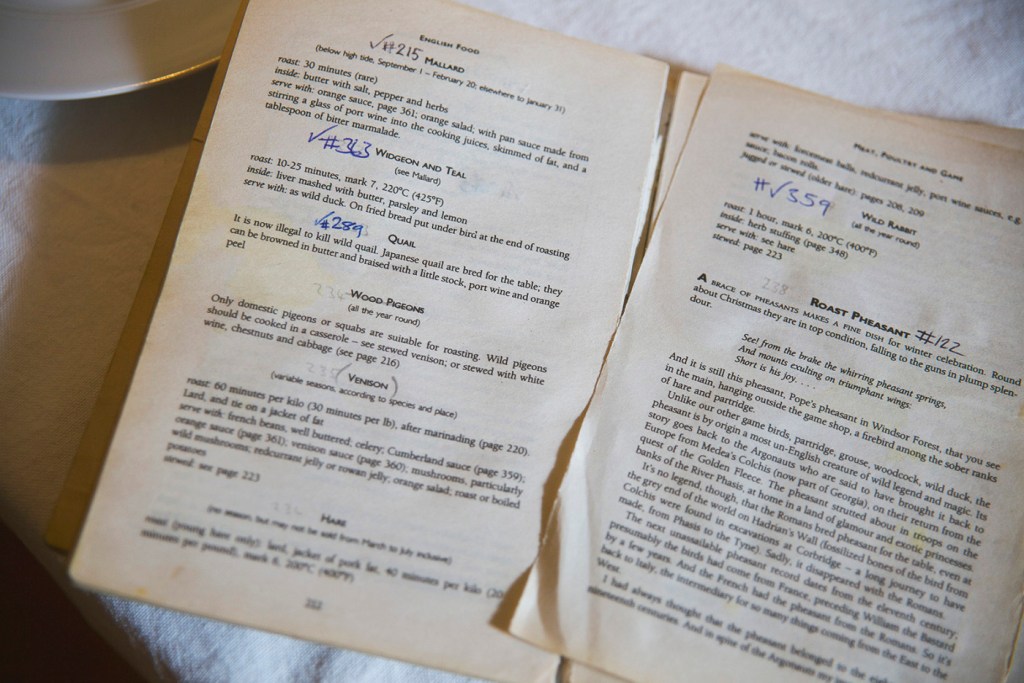
Hello lovely followers. Just a quickie to let you know that the sister blog to British Food: A History, Neil Cooks Grigson has moved from Blogger to WordPress. It makes much more sense to have them on the same format.
If you’ve never checked it out, now is your chance – there’s over 400 recipes on there, all fully reviewed. There are some amazing ones, and a fair few disasters, warts and all. So if there’s a classic English dish or recipe you’ve always wondered about, chances are I’ve cooked it up.
Just click on this link here and follow – I’d be most grateful!
I’ll be putting a few posts on there to help newcomers get up to speed on the project in the coming weeks, so keep an eye out.
Over and out!
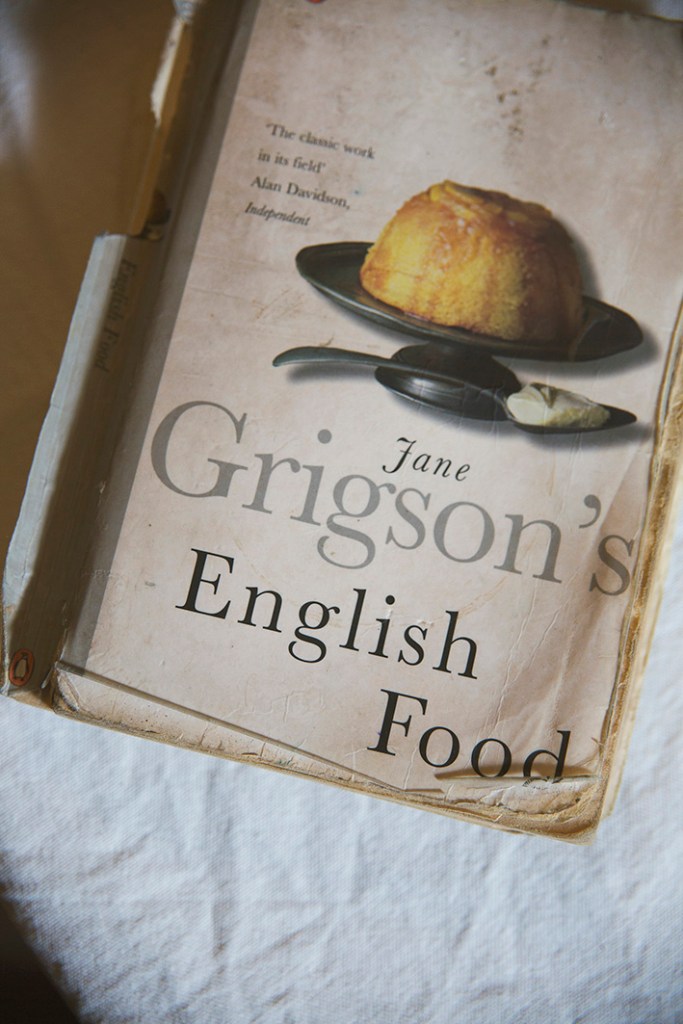
Third Course: ‘Mutton to eat as venison’ with Lenten Pie
Here we are at the mid-way point of the Dinner Party Through Time and we have arrived in the Georgian period with two great recipes inspired and stolen from the excellent 18th century cook book The Experienced English Housewife by Elizabeth Raffald. The book and the great lady herself deserve a post to themselves really; it lets such a light into the world of grander houses during that time. It’s a book I often leaf-through, so it was the obvious choice.
I thought that the course should be from opposite ends of the gastronomic spectrum with a rich leg of mutton, specially prepared to taste just like venison, and a Lenten pie, specially made for fast days and full of lovely vegetables and herbs.
To dress a Leg of Mutton to eat like Venison
Get the largest and fattest leg of mutton you can get cut out like a haunch of venison as soon as it is killed, whilst; it will eat the tenderer. Take out the bloody vein, stick it in several places in the under side with a sharp pointed knife, pour over it a bottle of red wine, turn it in the wine four or five times a day for five days. Then dry it exceeding well with a clean cloth, hang it up in the air with the thick end uppermost for five days; dry it night and morning to keep it from being damp or growing musty. When you roast it cover it with paper and paste as you do venison. Serve it up with venison sauce. It will take four hours roasting.
It was very intriguing, but it was also obviously unachievable. Looking in other books, I found many versions of it, sometimes roasted, sometimes braised, but always marinated in red wine (and often in the blood of the beast too!). I knew the recipe looked familiar, and it finally dawned on me that an updated recipe for it appeared in good old English Food by good old Jane Grigson. It’s not served with a rich venison sauce, but a gravy made with the cooking liquor
There’s a 4 day marinating time for this recipe, so plan ahead if you fancy making it. It is worth it, this is one of the most delicious things I have ever cooked and eaten. It is beautifully gamey, but with the moist succulence you would expect from lamb or mutton. It is magically transformed! Witchcraft can only be to blame.
Here’s what you need:
1 full leg of mutton (or lamb)
For the marinade:
250g onions, chopped
250g carrots, chopped
100g celery, chopped
4 or 5 cloves of garlic, chopped
3 tbs sunflower oil or lard
2 bay leaves
3 good sprigs of thyme
6 sprigs of parsley
3 sprigs of rosemary
12 crushed juniper berries
12 crushed coriander seeds
15 crushed black peppercorns
1 tbs salt
750ml red wine
175ml red wine vinegar
To cook the mutton:
3 onions, sliced
3 carrots, diced
3 celery stalks, sliced
3 leeks, sliced
375g unsmoked streaky bacon, chopped
90g salted butter
Veal stock or water
To make the marinade, fry the vegetables in the oil or fat. Take your time over this and get them good and brown; the veg won’t be in the final dish, but their flavour will be. Let them cool, and mix with the remaining marinade ingredients.
Score the fat of the leg into a diamond pattern, like you would do for a ham. Find a large, deep dish or pot and place the lamb inside and pour over the marinade. Make sure the whole leg gets the marinade on it, so turn it over a few times. Keep the leg somewhere cool – a fridge, or a nice cool cellar or pantry – and cover it with foil. Turn it twice a day for four days.
When the four days is up, get the new set of vegetables ready. To cook the mutton, spread the prepared vegetables over the base of a deep roasting tin, place the leg on top and strain the marinade over it. Top up the marinade liquid with veal stock or water so that it comes up two-thirds of the way up the tin. Cover with foil.
You have two choices now: either bring the whole thing slowly to boil and simmer gently for 3 hours on the hob, or bring to simmer and pop it in a cool oven instead, 150⁰C will do it, for a similar amount of time. Turn the joint over after ninety minutes and in the final half an hour, ladle out 2 pints of the cooking liquid and boil it down hard to make a concentrated, richly flavoured stock.
When the cooking time is up, remove the leg and put it into another roasting tin and turn the oven up to 220⁰C. Roast for a good 20 minutes and baste well with the concentrated stock to achieve a nice glaze. Any remaining concentrated stock can be used as gravy.
An Herb Pie for Lent
Take lettuce, leeks, spinach, beets and parsley, of each a handful. Give them a boil, then chop them small, and have ready boiled in a cloth one quart of groats with two or three onions in them. Put them in a frying pan with the herbs and a good deal of salt, a pound of butter and a few apples cut thin. Stew them a few minutes over the fire, fill your or raised crust with it, one hour will bake it. Then serve it up.
Groats are whole grains of cereals and oats or barley could have been used, but I chose whole wheat. The only change I made was to use a normal shortcrust pastry and make a regular double-crust pie in a tin, rather than a raised crust with a hot water pastry. I regret that a bit now, but I wasn’t as good at pastry then as I am today. It is a good pie – some plainer cooking that married very well with the rich meat.
Here’s how I approached the recipe:
1 onion, chopped
oil or butter
150g wholewheat groats
generous knob of butter
2 Cox’s apples, peeled, cored and sliced
2 little gem lettuce, sliced
1 leek, sliced
1 medium golden beetroot, diced
1 handful of spinach, rinsed
1 bunch parsley, chopped
shortcrust pastry
Begin by gently frying the onion in a little butter or oil until soft and golden. Add the groats and cover with water. Simmer gently until the groats are tender, topping up with more water if things look a little dry. Season with salt and pepper and allow to cool. Meanwhile fry and soften the apples in butter and let those cool too.
Mix the apples with the groats and the remaining vegetables and line a pie tin with shortcrust pastry. Tip in the mixture and cover with more pastry in the usual way.
Glaze with beaten egg and bake at 200⁰C for 20 minutes until golden, then turn down to 175⁰C for 35 to 40 minutes.
If you like the blogs and podcast I produce, please consider treating me to a virtual coffee or pint, or even a £3 monthly subscription: follow this link for more information.
Filed under Britain, cooking, Eighteenth Century, food, General, history, Meat, Recipes, Uncategorized, Vegetables




